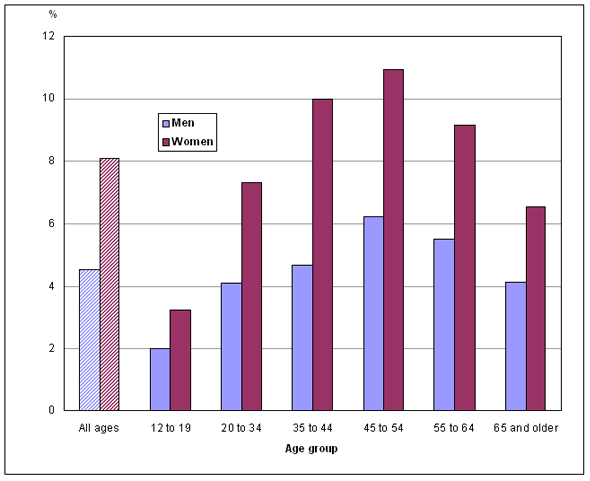Mood disorders, 2009
Archived Content
Information identified as archived is provided for reference, research or recordkeeping purposes. It is not subject to the Government of Canada Web Standards and has not been altered or updated since it was archived. Please "contact us" to request a format other than those available.

Mood disorders, such as depression and bipolar disorder, can greatly affect the lives of those who have them. The impact of depression on job performance has been estimated to be greater than that of chronic conditions such as arthritis, hypertension, back problems and diabetes.
The data used for this health indicator are based on a survey question that asked about mood disorders diagnosed by a health professional, such as depression, bipolar disorder, mania or dysthymia.
The percentage of Canadians reporting a diagnosed mood disorder rose from 5.3% in 2003 to 6.3% in 2009. Throughout this period, women reported significantly higher levels of mood disorders than did men.
In 2009, only the 35– to 64–year–old age groups had above-average levels of mood disorders. Levels among 12– to 34–year–olds and those 65 and older were below the national average. Women reported significantly higher levels of mood disorders than did men in each age group (Chart 1). This is a new situation in 2009 for those 65 and older, since there was no difference between the sexes in this age group in 2008.
Chart 1
Percentage reporting mood disorders, by age group and sex, household population aged 12 and older, Canada, 2009

Source: Canadian Community Health Survey, 2009.
Posting higher rates of diagnosed mood disorders than the national average in 2009 were Ontario, 6.8%; British Columbia, 7.3%; and Yukon, 10.6%— which should be interpreted with caution. Rates in Newfoundland and Labrador, 4.4%, and Quebec, 4.6%, were below the national average. In all other provinces and territories, the percentages were indistinguishable from the national average.
References
Orpana, Heather, Louis Lemyre and Ron Gravel. 2009. "Income and psychological distress: The role of the social environment." Health Reports, 20(1): 1–8. /pub/82-003-x/2009001/article/10772-eng.pdf (accessed May 10, 2010).
Gilmour, Heather and Scott B. Patten. 2007. "Depression and work impairment." Health Reports, 18(1): 9–22. /pub/82-003-x/2006001/article/depress/82-003-x2006001-eng.pdf (accessed May 10, 2010)
Shields, Margot. 2006. "Stress and depression in the employed population." Health Reports, 17(4): 11–29. /studies-etudes/82-003/archive/2006/9495-eng.pdf (accessed May 10, 2010)
Wilkins, Kathryn. 2004. "Bipolar I disorder, social support and work." Health Reports. 15 (supplement): 23–51. /pub/82-003-s/2004000/pdf/7443-eng.pdf (accessed May 10, 2010)
Data
Additional data from the Canadian Community Health Survey are available from CANSIM table 105–0501.
- Date modified:
